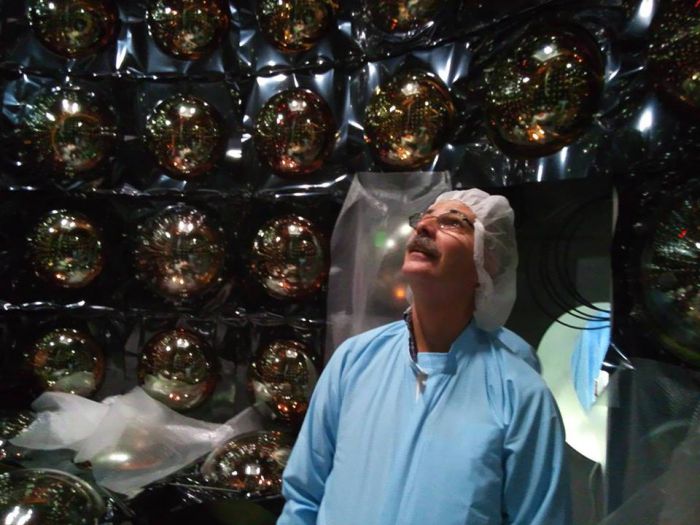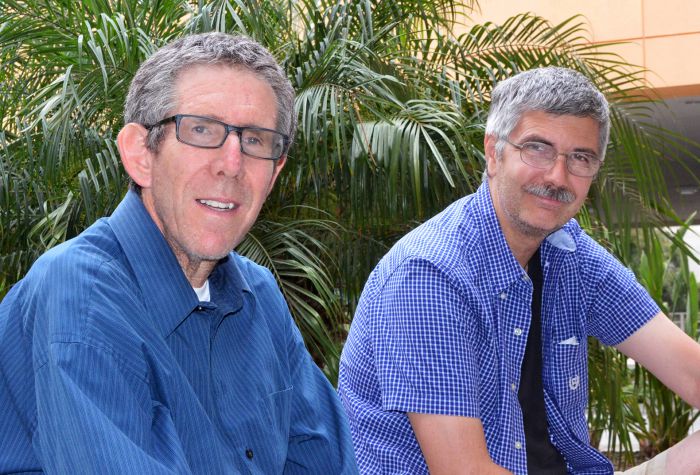By Laurie McLaughlin

A half-mile underground, an enormous steel tank is filled with 50,000 tons of water surrounded by light-detecting devices. It serves partly as a giant target for cosmic particles–like protons, electrons, and neutrons–raining down on Earth from the sky.
One type of particle, the neutrino, has been somewhat of a mystery to physicists until recent decades, but its activity helps explain how the sun and stars continue to shine.
“We don’t realize it, but trillions of neutrinos travel through our bodies every second,” said California State University, Dominguez Hills (CSUDH) professor of physics James Hill, who has been studying this very tiny phenomenon for more than 20 years. Neutrinos are subatomic particles similar to the well-known electrically charged electrons, but neutrinos don’t have an electrical charge.
“Therefore, neutrinos don’t react very strongly when they encounter matter, and they are very hard for scientists to detect and study,” added Hill. “Since they don’t interact with anything, most neutrinos make it straight through the Earth and keep going.”
Hill has conducted much of his research in Japan at the acclaimed Kamioka Observatory working on an experiment called Super-Kamiokande to explore the universe.
“Super-Kamiokande is essentially a very large sealed tank of very pure water with light sensors in it, and the whole thing sits underground in an old mine,” said Hill of the vessel that is nearly 140 feet tall and 130 feet wide.
Hill lived in Japan for several years as a researcher for both the observatory and StonyBrook University in New York, where he worked before joining the faculty at CSUDH in 2002. In 1998, he was part of a team of physicists from more than two dozen institutions across the world–including his future CSUDH colleagues, physics professor Ken Ganezer and lecturer William Keig–who produced evidence that neutrinos have mass.
Update: The 2015 Nobel Prize in physics was awarded to Takaaki Kajita for the 1998 discovery made at Super Kamiokande
“Pretty much all of what Super-Kamiokande studies is ‘pure science’ research, not things that are expected to have direct applications any time in the very near future,” said Hill. “There are also several other experiments in addition to this one, which are either currently operating or being built in the mine. “The goal is to get a deeper understanding of the universe.”

Hill now travels to Japan each year to work at the facility as an active collaborator. He was in Japan this past summer monitoring and calibrating the Super-Kamiokande’s equipment. Hill, along with Ganezer and Kieg also continue to contribute physics analysis related to the concept of “neutrino oscillations,” or as he explains it: “Neutrinos come in three types, but each can change into another type as it travels.”
Understanding what neutrinos are and how they work has only been uncovered by teams like those at the Super-Kamiokande in the last 20 years, including proof that neutrinos come from the sun.
“This may not sound critical to everyday life, but it was the first real proof that the sun, and by extension all stars, do in fact get their power the way we think they do,” he said. The sun’s fire is the result of a nuclear fusion reaction that transforms hydrogen into helium and releases energy, including the very weak neutrinos.
“This is really important if you want to understand how the stars and the universe work,” said Hill.
The seeming incongruity of studying stars from underground is not lost on scientists, says Hill, but given the nature of neutrinos, it is an effective way to detect them. The Super-Kamiokande’s large tank deep within the mine is shielded by a mountain that keeps other cosmic particles that do interact with matter from traveling down to the water. The neutrinos pass through the mountain and through the water. Because the tank is such a large target, it increases the chances of being “hit” by the occasional neutrino that will interact with the water and produce one or more charged particles. This movement is identified by the light detectors lining the tanks walls.
“Our 50,000-ton detector only has a couple dozen ‘hits’ in a day,” said Hill. “But knowing how seldom they interact means that there are many more present, and huge numbers of neutrinos from all the stars are floating randomly through the universe.”
Back on campus, Hill brings his experience from the mine to the classroom, where he teaches several courses to non-physics majors. He lets his enthusiasm guide his instruction.
“Because of my long experience with Super-Kamiokande, I’m always finding new examples for physical phenomena, and the students learn that science is a process rather than a set of facts,” he says. “I think we find the vast nature of the universe so intriguing simply because we are human.”